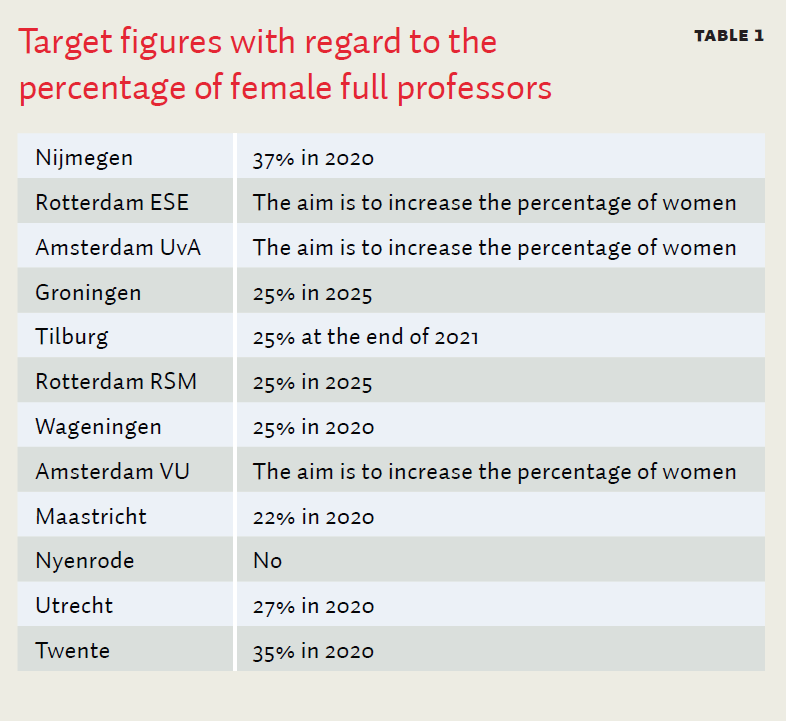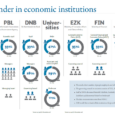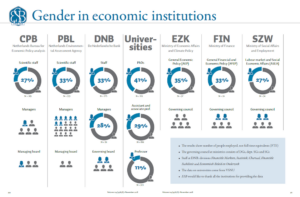A survey among the economics faculties in The Netherlands maps the initiatives being taken to increase the low share of women within the economics discipline. Is it enough?
Women in economics
Why is this article in English?
This article is part of our English publication ‘Women in Economics’. This dossier is in English because English is the main language of the economics and business faculties in the Netherlands, so an ESB dossier about the people who work there should be in English.
The Dutch version of this article can be found here.
In brief
– All economics faculties are taking measures to promote diversity.
– Compliance can be improved; policy is all too often the sum of good intentions.
– Positive role models and leave policies during the tenure track require more attention.
Women are scarce in the economics debate (Teunissen and Hogendoorn, 2018). There are also very few women with senior positions in the economics discipline. In fact, there is no discipline in the Netherlands in which the proportion of women among full professors is as low as in economics, that is 10.4 percent in comparison to a national average of 19.1 percent (Rathenau Instituut, 2018). Interestingly, this seems to be an international phenomenon, as in the United States women are also highly underrepresented within the economics profession (Bayer and Rouse, 2016). Several authors have tried to understand why; others have pointed out possible consequences (Bayer and Rouse, 2016; May et al., 2013; 2018; Teunissen and Hogendoorn, 2018). The central question in this contribution is: what are we, as a discipline, doing about it?
To find out about this, I conducted a small survey last spring among the Dutch economics and business administration faculties (FEBs) with the query what faculties are actually doing to become more ‘gender diverse’. Do they recognize the problem and, if so, what does this mean for their selection and recruitment policy? All of the economics and business administration faculties organized within the DEB (Deans of the disciplines of Economics and Business Administration in the Netherlands) have provided information in this respect.
Awareness
By now, most universities acknowledge the importance of diversity. In most cases it is also recognized that a gender-diverse university does not come about automatically, but that a targeted policy must be developed. As a first step, many universities have appointed a diversity manager, with the assignment to make the university more ‘inclusive’. Usually such a manager has a broad task, meaning that it is not only about gender issues, but also about cultural and ethnic diversity. In some cases, an explicit responsibility for diversity also applies at faculty level. This is, for instance, the case at Amsterdam University (UvA), where the FEB has appointed a diversity officer as of 1 July 2017. In Rotterdam, RSM has an associate dean of diversity, while the Erasmus School of Economics (ESE) has given two employees the explicit task (0.1 FTE) to provide the university policy plan with some clout at faculty level.
A more inclusive university naturally requires awareness among the seated staff. Various faculties provide the possibility to do a ‘bias training’ or a course ‘selection without judgment’. The target group may vary somewhat, but most of the time this concerns full professors and/or members of appointment advisory committees (BACs). In Groningen, for example, all senior staff followed a course ‘diversity & inclusion for senior staff’. In other faculties, the policy seems less binding. In Tilburg, a pilot was developed in 2017 with the aim to “reduce the effect of gender bias in the selection process”. It is expected that in the summer of 2018 an adapted module will have been developed for a new pilot due to be held. Rotterdam (RSM/ESE) also focuses on ‘planning’, while in Maastricht ‘suggestions’ are made in this direction. UvA states that this is not a theme to which explicit attention is given, and the same goes for Nyenrode.
Apart from a training, awareness can of course also be raised in other ways, for instance by the invitation policy for seminars or by teaching. However, also in these areas the score seems rather meagre. No faculty has in fact explicitly developed a policy with regard to the invitation policy for seminars. Rotterdam (RSM) states: “For the invitation of guest speakers, the criteria of the ERIM support plan for visits apply. This means scientists with publications in top-tier journals.” Some faculties claim that gender diversity is taken into account in the sense that during seminars a ‘healthy’ composition of speakers is ensured: “We really pay attention to the fact that there are not only men on stage” (VU). In addition, references are made towards the diversity officer or the HR department, and their responsibilities in this respect. This mainly involves the roll-out of a strategic personnel policy, so that a more inclusive university is realized.
Awareness also requires positive role models. Without positive and appealing examples, it is difficult for young women (and men) to imagine that women can also be successful within the economics discipline. A good role model literally and figuratively opens doors and lowers, for example, the threshold towards applying for a job as a tenure tracker or – later on in one’s career – as a full professor.
Tenure track
An important step in an academic career is gaining a position as a tenure tracker. Here and there, the realization seems to be dawning that, if a few preconditions are not met, the selection process might disadvantage female candidates. For example, various faculties are requiring search committees to also have female members. UvA states for instance that for several years now, serious efforts have been made to invite as many women as men to job interviews, actually ‘with varying degrees of success’. In Tilburg a department this year instructed the search committee to offer half of the fly-outs (job interviews for tenure tracks) to female candidates. And in Twente they have a similar goal: “The starting point is that fifty percent of the pre-selection consists of female candidates.” As to the other faculties, there are no specific conditions applying.
A subject that in fact did receive the necessary attention at most faculties is how to deal with pregnancy and maternity leave, especially during tenure track. Most faculties (Utrecht, Nijmegen, Tilburg, Groningen, Rotterdam (RSM/ESE), Wageningen and Twente) do compensate for the leave’s duration by extending the appointment and postponing the assessment moment. Also, at most faculties, educational duties are reduced. There is, however, no uniform regulation. UvA is for instance rather reticent. The faculty is ‘on the verge’ of adjusting the tenure assessment and the tenure track’s duration so that there will be more room for particular circumstances, such as pregnancy and maternity leave. “The duration of the expansion is still under discussion, the exact outcome has not yet been determined.”
Full Professor
The pinnacle of the academic career is the appointment to professor. There, the discussion about a more proportional representation also acquired the highest profile (LNVH, 2017). Within economics, there is an extra focal point here because the share of female professors is well below the national average. So, what actions are being taken to change this?
In most faculties, the standing policy is that all BACs must at least have one female member. In Groningen, the standard is that a BAC has at least two female members. In Maastricht, the rule is that women at least have a thirty percent share. The UvA is once again rather reluctant: although the university has a policy that all BAC’s should have at least one female member, this requirement does not apply at faculty level. Nor does Nyenrode set any further conditions for the BAC’s composition.
In most faculties, therefore, one is working on awareness and attempting to give shape to the selection process without prejudice. However, the procedure’s continuation is hardly compulsory. When asked about the invitation policy, most faculties answer that one ‘aims’ to appoint more women. Or “whenever possible, at the very least one woman is invited for an interview”. Rotterdam (RSM) is more explicit and states that the policy is that, given one’s aim to appoint fifty percent women, women are always invited. Maastricht also has an explicit policy line: the BAC is supposed to nominate at least five suitable candidates, including at least two women. In addition, most universities have guidelines as to the percentage of female professors, and many faculties have committed themselves to these; see table 1 for the ambitions in this respect.

Of course these are a ‘target figures’ and there is a ‘best-effort obligation’, while there are no hard penalties for not complying with the agreement. Various faculties also indicate that the university’s target figures are indeed ambitious. For instance, Groningen explicitly questions the feasibility of the 25 percent target in 2025, given the percentage of 13 percent in 2018.
There are at least two approaches in order to show a bit more ambition here. The first approach is to develop additional policies, so that successful associate professors (or tenure trackers) receive a helping hand in their academic career. The second approach is to set up or participate in a programme that explicitly focuses on increasing women’s share in the senior staff.
The first approach, an additional policy, is tentative at the outset. When asked whether female associate professors or female professors are entitled to extra support such as coaching, most faculties say that all employees within the faculty are entitled to extra support, and that in practice one often avails oneself of coaching. Rotterdam ESE also states that they have plans for a new programme focusing on female academic staff. Rotterdam RSM has various mentoring, coaching and training programmes aimed at female associate professors. Utrecht University (UU) has a similar programme for female university teachers, and in Wageningen one uses a buddy system.
A well-known example of the second approach, a policy explicitly aimed at women, is the so-called Westerdijk Talent Impuls, with which the Ministry of Education, Culture and Science in 2017 was able to realize 100 additional chairs for female professors in the Netherlands. This in order to celebrate the fact that, 100 years ago, in 1917, Johanna Westerdijk was appointed as the first female professor in the Netherlands. It is not known how these chairs are divided over the disciplines; it is therefore unclear how many female associate professors were promoted to full professors within economics due to this incentive.
In addition to this national initiative, there are also university incentive programmes. For example, Tilburg has the Philip Eijlander diversity programme (PEDP), which aims to increase the percentage of women in higher academic positions by creating additional positions for university teachers, associate professors and professors. The ultimate goal – according to the website – is “to create an inclusive work climate in which quality comes first. Equal opportunities for all will lead to a better use of capacities and a fair representation of women in higher academic positions.” 13.5 percent of the current female professors in Tilburg have been appointed by way of the PEDP. Up to now, the economics faculty has mainly focused on extra positions for university teachers, yet within the PEDP programme’s second round, there will be one associate professor’s position and one professor’s post. Another example is Groningen where the Rosalind Franklin Fellowship programme (RFF) was set up for talented female PhDs. The candidates are selected for a tenure track position, with as ultimate goal a permanent appointment as full professor. Over the past few years, around 100 women have been appointed to this programme, of whom about 80 are still employed. The Faculty of Economics and Business Administration has approximately seven ‘RFF’ employees, two of whom are now full professors.
Conclusion
The above inventory shows that diversity is regarded more and more as a point of attention, also within the economics discipline. At the same time, it is also apparent from this inventory that the changes are not introduced with a great sense of urgency. Many measures are still at the provisory stage – the selection needs to be more balanced, so a bias training is organised and so all BAC’s should have at least one female member. But of course in doing so the outcome is not per se more diverse. The most successful programmes seem to be the additional ones specifically designed for women. In other words: as long as there are extras, women are being appointed. However, women are still not gaining a foothold through the regular application and employment policies.
Three recommendations spring to mind. The first is that one should start earlier. At present, entire generations of students are still being trained without appealing role models. If students are never taught by a female professor, it is not very surprising that these students have certain prejudices as regards female scientists or female supervisors, during their studies but also later on in their career. This argues in favour of a bias training as a standard part of a bachelor’s student’s skills program.
A second recommendation is to look again at the tenure track policy, and particularly at how this deals with pregnancy and childbirth. The current rather casuistic approach seems to indicate that extra timer is more of a favour than of a right, and implicitly confirms the idea that a scientific career cannot be combined with any other responsibility. A more generous standard arrangement – for instance that at every baby one is entitled to a year’s extension – provides more elbow room and shows that one is more understanding of other responsibilities. The third recommendation is that the implemented policy should be more strictly observed. At present, it is often simply a sum of good intentions and therefore too non-committal. Gender diversity is still too much of a female issue in the guise of an additional programme. Everyone, men and women, should be committed to shaping selection and assessment criteria that are both relevant and fair.
References
Bayer, A. and C.E. Rouse (2016) Diversity in the economics profession: a new attack on an old problem. Journal of Economic Perspectives, 30(4), 221–242.
LNVH (2017) Monitor vrouwelijke hoogleraren 2017. Utrecht: Landelijk Netwerk Vrouwelijke Hoogleraren.
May, A.M., M.G. McGarvey and R. Whaples (2013) Are disagreements among male and female economists marginal at best?: a survey of AEA members and their views on economics and economic policy. Contemporary Economic Policy, 32(1), 111–132.
May, A.M., M.G. McGarvey and D. Kucera (2018) Gender and European economic policy: a survey of the views of European economists on contemporary economic policy. Kyklos, 71(1), 162–183.
Rathenau Instituut (2018) Het aandeel vrouwelijke hoogleraren in Nederland en EU-landen. Data available at www.rathenau.nl.
Teunissen, S. and C. Hogendoorn (2018) Weinig vrouwen in het economisch debat. ESB, 19 March. Available at esb.nu.
Auteur
Categorieën









